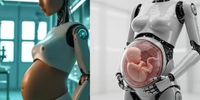At the 2025 World Robot Conference in Beijing, the future of human reproduction took a startling turn. Dr. Zhang Qifeng, founder of Kaiwa Technology in Guangzhou, stepped onto the stage and unveiled a plan that sounds straight out of science fiction: a humanoid robot equipped with a fully integrated artificial womb, capable of carrying a pregnancy to term and delivering a human baby. If all goes according to plan, the first working prototype could debut as soon as 2026, heralding a new era in reproductive technology and sparking a global debate about ethics, legality, and the very meaning of parenthood.
This bold innovation combines two cutting-edge fields: artificial womb technology and humanoid robotics. According to CyberNews and the New York Post, Kaiwa Technology’s system features an artificial womb designed to mimic the human uterus with remarkable precision. The robot’s womb, nestled within its abdomen, would receive nutrients, oxygen, and maintain optimal temperature through a sophisticated delivery system, supporting fetal development from conception to birth over a full ten-month gestation. Synthetic amniotic fluid and advanced monitoring systems would ensure the fetus develops in an environment as close as possible to nature’s own.
Dr. Zhang Qifeng explained that the robot manages every stage—from fertilization and implantation to full-term pregnancy and delivery. “The womb is fully integrated into the robot’s body and capable of managing every stage from fertilization and implantation to full-term pregnancy,” Dr. Zhang stated at the conference, according to CyberNews. The company has already begun discussions with provincial officials in Guangdong and submitted policy proposals to navigate the complex regulatory terrain, as reported by BBC and CyberNews.
The potential benefits are significant. For millions of couples struggling with infertility, the pregnancy robot could offer a new path to parenthood. The cost, projected at around 100,000 yuan (approximately $13,900 to $19,200 USD), is dramatically lower than traditional surrogacy, which can range from $80,000 to $200,000 USD, depending on the country and legal complexities. “This innovation could become a more affordable alternative to traditional surrogacy, which often comes with high costs and complex legal challenges,” CyberNews noted. The system also promises to ease the physical and emotional burdens that pregnancy can place on human mothers, potentially offering a safer and less stressful experience.
But if this all sounds too good to be true, that’s because the road ahead is riddled with uncertainty. For starters, the technical challenges are immense. Experts are still puzzling over how exactly fertilization would occur, how the embryo would be safely inserted into the artificial womb, and how the robot would ultimately deliver the baby. Maintaining the delicate balance of hormones, temperature, and immune protection—elements naturally provided by a human mother—remains a daunting hurdle. And what happens if the robot malfunctions during pregnancy or delivery?
Then there’s the legal minefield. Chinese law currently prohibits developing human embryos in artificial environments for more than 14 days, and commercial surrogacy is outright banned. As BBC and CyberNews have reported, for Kaiwa Technology’s vision to become reality, regulators would need to rewrite fundamental bioethics rules. The company’s ongoing “discussion forums” with Guangdong authorities are just the beginning. “No authority has given it permission to proceed with human gestation, and it is difficult to see how such approval could be granted without rewriting fundamental bioethics rules,” BBC observed.
Ethical concerns loom even larger. Critics have not minced words, with some calling the idea “dehumanising” and “a violation of human ethics.” On Chinese social media, reactions have ranged from horror to cautious hope. One commenter lamented, “It’s cruel for a baby to be born without connection to a mother. This violates everything we know about human life.” Another, reflecting on the potential for abuse, warned, “Whoever controls the ‘pregnancy robots’ owns the future.” Fears abound that the technology could further commodify childbirth, turning reproduction into a service industry and deepening class divides—tech-driven fertility options for the wealthy, while others are left behind.
Some users on X (formerly Twitter) have taken the debate further, speculating about state or corporate misuse. “Nations with collapsing birth rates (China, Japan, South Korea) are desperate. A synthetic womb bypasses women entirely—production of citizens as a state-run supply chain,” one user wrote, highlighting the potential for engineered populations and manufactured loyalty. The specter of mass-produced, state-owned children or genetically tailored citizens is enough to send chills down anyone’s spine.
Yet, not everyone is opposed. For those who have faced the heartbreak of infertility, the pregnancy robot could be a lifeline. One woman, after multiple failed IVF cycles, told Chinese media, “If this is real, it could be my last chance to have a baby.” The divide is stark: for some, liberation; for others, a dystopian nightmare.
The global context adds another layer of complexity. While China is racing ahead, other countries like the United States and Japan are already testing artificial wombs for premature babies—but not for full pregnancies. If China succeeds, it could ignite a reproductive tech race as populations shrink worldwide, as CyberNews pointed out.
For now, the pregnancy robot remains a provocative promise, not a medical reality. The prototype’s debut in 2026 will be watched closely by scientists, ethicists, lawmakers, and the public alike. As Dr. Zhang Qifeng emphasized, clear legal and ethical guidelines will be essential to ensure the technology is applied responsibly. “Important debates include the definition of parenthood, the rights of a child born via robotic gestation, and broader societal implications,” Dr. Zhang stated at the World Robot Conference, according to CyberNews.
In the meantime, the project has already succeeded in sparking a profound debate: What does it mean to be human, to be a parent, to be born? As the world stands on the cusp of a new era in reproductive medicine, the questions raised by China’s pregnancy robot are as urgent as they are unsettling. The coming years will determine not just the fate of this technology, but the values and boundaries of society itself.





